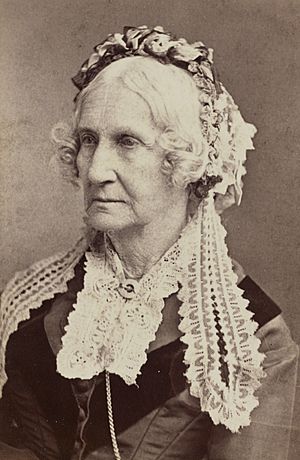Nancy Maria Donaldson Johnson facts for kids
Quick facts for kids
Nancy Maria Donaldson Johnson
|
|
|---|---|

Portrait of Johnson, c. 1875
|
|
| Born |
Nancy Maria Donaldson
December 28, 1794 New York, U.S.
|
| Died | April 22, 1890 (aged 95) Washington, D.C., U.S.
|
| Resting place | Oak Hill Cemetery Washington, D.C., U.S. |
| Occupation | Inventor |
| Known for | patenting the hand-cranked ice cream freezer |
| Spouse(s) |
Walter Rogers Johnson
(m. 1823; died 1852) |
Nancy Maria Donaldson Johnson (born December 28, 1794 – died April 22, 1890) was an amazing American inventor. She is famous for creating the first hand-cranked ice cream freezer. She received a patent for her invention in 1843, which changed how people made and enjoyed ice cream forever!
Contents
Nancy Johnson's Early Life
Nancy Maria Donaldson was born in New York in 1794. In 1823, she married Walter Rogers Johnson in Medfield, Massachusetts. They adopted two children: Walter W. Johnson and Mary Maria Stroud. The family lived in Philadelphia for most of Nancy's life.
Nancy's husband, Walter, was a scientist. He was the First Secretary for the American Association for the Advancement of Science.
A Woman Ahead of Her Time
Nancy started as a housewife, which was common for women back then. But she became a very successful inventor, which was quite rare! In her time, women often didn't have the same rights as men. When a woman married, she usually couldn't control her own money or property. Men were expected to handle all legal and financial matters for their wives and daughters.
Nancy Johnson was a social empowerer. She showed women that they could create their own path and make a difference. Her invention helped break down some of these old rules.
Inventing the Ice Cream Maker
Before Nancy's invention, making ice cream was a lot of hard work. It could take one person many hours to churn it by hand. Nancy invented the hand-cranked ice cream churn to make this process much faster and easier.
She filed for her patent for the first hand-cranked ice cream churn in 1843. Her simple invention, called the "Artificial Freezer," made it possible for everyone to make good quality ice cream without needing electricity.
How the Artificial Freezer Worked
The Artificial Freezer had a special design. It used a hand crank that spun two flat blades with holes. These blades helped mix the ice cream evenly. They also scraped ice crystals off the inside walls of the container.
The blades were attached to a part called a "dasher," which connected to the crank handle. The machine also had a wooden tub that held a mix of salt and crushed ice. This mixture made the temperature drop very low, freezing the ice cream inside. Nancy even designed it so you could make two different flavors at once!
This invention made it much easier and cheaper for ice cream shops to make their products. Because it was cheaper to make, ice cream became more affordable for everyone. Before this, it was often too expensive for many families.
Later Life and Legacy
Starting in 1862, Nancy and her sister Mary volunteered to teach freed slaves in South Carolina. This was part of a program called the Port Royal Experiment.
Nancy received $1500 for her patent during her lifetime. She made her final changes to the patent in 1843. Later, she sold the rights to her invention to William G. Young for $200. Young then made some improvements to the ice cream freezer.
Nancy Johnson died in Washington, D.C. in 1890. She and her family are buried at Oak Hill Cemetery.
Today, ice cream is one of the most popular desserts around the world. In 2019, people in the U.S. made about 6.4 billion pounds of ice cream and frozen yogurt! The ice cream industry also creates many jobs and contributes billions of dollars to the U.S. economy.
See also
 In Spanish: Nancy Maria Donaldson Johnson para niños
In Spanish: Nancy Maria Donaldson Johnson para niños

